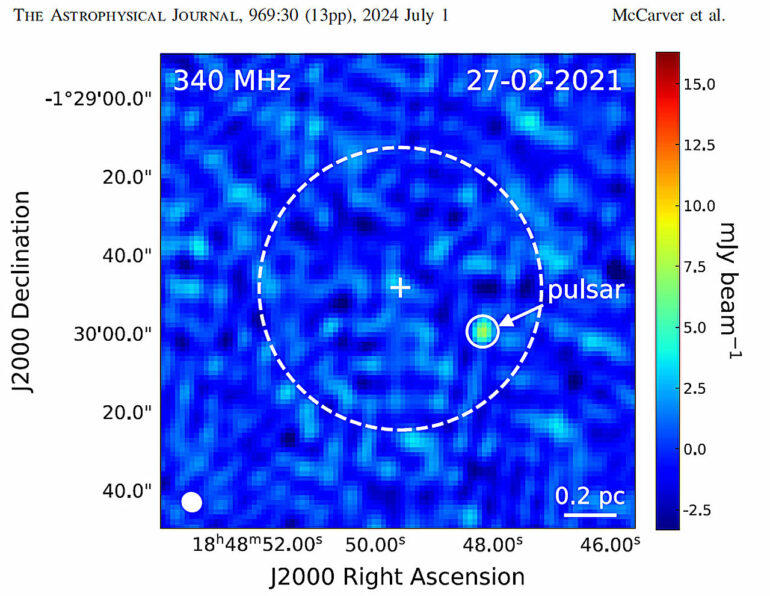U.S. Naval Research Laboratory (NRL) Remote Sensing Division intern Amaris McCarver, along with a team of astronomers, has discovered the first millisecond pulsar in the stellar cluster Glimpse-CO1 and recently published findings in The Astrophysical Journal.
Pulsars are natural laboratories for studying the behavior of matter under extreme gravitational and magnetic fields—conditions difficult or impossible to replicate on Earth.
They also function as natural timekeepers. Precise timing of the observed pulses from an array of pulsars offers a means to detect gravitational waves propagating through our galaxy from the merging supermassive black holes that result from galaxy collisions. Some pulsars are observed to have an accuracy and stability comparable to our most precise atomic clocks. These pulsars hold the potential to establish a “celestial GPS” system for satellite navigation in space.
McCarver’s team used images from the Karl G. Jansky Very Large Array (VLA) Low-band Ionosphere and Transient Experiment (VLITE) to search for new pulsars in 97 stellar clusters.
“It was exciting so early in my career to see a speculative project work out so successfully,” said McCarver. Her new approach of using VLITE images coupled with images from several radio surveys at different frequencies identified multiple candidate pulsars, with the strongest candidate residing in a system known as GLIMPSE-C01.
“This type of scientific discovery is only possible thanks to the collaboration between NRL and the National Radio Astronomy Observatory that enabled this continual dual-frequency capability on the VLA,” said Tracy E. Clarke, Ph.D., NRL Remote Sensing Division astronomer.
“This research highlights how we can use measures of radio brightness at different frequencies to find new pulsars efficiently, and that available sky surveys combined with the mountain of VLITE data mean those measurements are essentially always available. This opens the door to a new era of searches for highly dispersed and highly accelerated pulsars.”
The presence of a millisecond pulsar, designated GLIMPSE-C01A, was confirmed through re-processing of archival data from the Robert C. Byrd Green Bank Telescope. Millisecond pulsars, such as GLIMPSE-C01A, are born in supernova explosions and are spun up by consuming material from a companion star.
“Millisecond pulsars, or MSP, offer a promising method for autonomously navigating spacecraft from low Earth orbit to interstellar space, independent of ground contact and GPS availability,” said Emil Polisensky, Ph.D., an NRL Remote Sensing Division astronomer. “The confirmation of a new MSP identified by Amaris highlights the exciting potential for discovery with NRL’s VLITE data and the key role student interns play in cutting edge research.”
McCarver received the Robert S. Hyer Research Award from the Texas Section of the American Physical Society (APS). McCarver was one of 16 summer of 2023 interns in the Radio, Infrared, Optical Sensors Branch at NRL DC that participated in internships through the Science Engineering Apprenticeship Program and NREIP, Historically Black College and University/Minority Institution High Performance Computing Internship Program, and the U.S. Naval Academy Midshipmen Internship Program. She will graduate with a degree in Physics and Astronomy and plans to pursue her graduate education in astronomy.
More information:
Amaris V. McCarver et al, A VLITE Search for Millisecond Pulsars in Globular Clusters: Discovery of a Pulsar in GLIMPSE-C01, The Astrophysical Journal (2024). DOI: 10.3847/1538-4357/ad4461
Provided by
Naval Research Laboratory
Citation:
Research intern helps discover a new pulsar buried in a mountain of data (2024, July 1)



